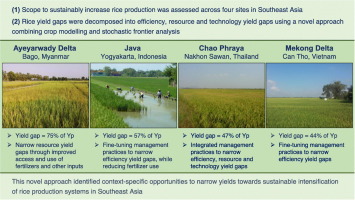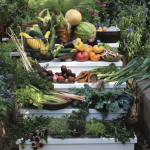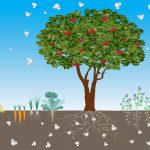Imagine a world where every grain of rice you eat not only fills your plate but also contributes to a healthier planet. That world is possible, and it starts with you.
As rice is a staple food for millions across Asia, the way it’s cultivated holds immense power to shape our future. But what if you could be part of a movement that transforms traditional farming into something more sustainable, more eco-friendly?
With sustainable rice cultivation techniques, you can be that change. Learn how these innovative methods not only boost productivity but also safeguard our precious environment. Discover the secrets to nurturing your land while feeding your family, your community, and beyond. Dive into the world of sustainable rice farming and unlock the potential to make a real difference. Ready to explore how you can cultivate a brighter, greener future? Keep reading to find out how.
Eco-friendly Farming Practices
Eco-friendly farming practices are crucial in sustainable rice cultivation. Asia, home to vast rice fields, relies heavily on rice production. Efficient, green techniques ensure environmental balance and healthy harvests. Farmers adopt methods that minimize harm to nature. These practices increase yields and reduce costs.
Water Management Techniques
Effective water management conserves resources. Alternate Wetting and Drying (AWD) is a popular method. It reduces water use and methane emissions. Farmers flood fields for specific periods. Then, they allow them to dry. This cycle maintains soil health and supports sustainable growth.
Integrated Pest Management
Pests threaten rice crops and reduce yields. Integrated Pest Management (IPM) tackles this problem. It uses biological controls and reduces chemical use. Farmers plant pest-resistant rice varieties. They introduce natural predators into fields. This approach keeps pests under control.
Organic Fertilizers
Many farmers switch to organic fertilizers. These enrich soil naturally. They reduce chemical dependence and promote healthy crops. Compost, green manure, and animal waste are common choices. Organic materials improve soil structure and nutrient levels.
Crop Rotation
Crop rotation enhances soil health and fertility. Farmers alternate rice with other crops. This reduces disease risk and pest buildup. Rotated crops include legumes and vegetables. They replenish nutrients and support sustainable farming.

Water Management Strategies
Water management is vital in sustainable rice cultivation. Rice needs a lot of water to grow. Without proper strategies, water can be wasted. In Asia, farmers use smart methods to manage water. These methods help save water and ensure rice grows well. Let’s explore some effective techniques.
Traditional Flooding Method
Many farmers use flooding to grow rice. Fields are filled with water regularly. This helps control weeds and pests. It also keeps the soil fertile. But, it requires a lot of water.
Alternate Wetting And Drying (awd)
AWD is a popular method in Asia. It involves flooding fields and then letting them dry. This reduces water usage significantly. Farmers can monitor soil moisture easily. AWD also improves soil health.
Drip Irrigation
Drip irrigation provides water directly to plant roots. This method uses less water than flooding. It helps maintain consistent moisture levels. Drip irrigation is effective in water-scarce regions.
Rainwater Harvesting
Harvesting rainwater is sustainable. Farmers collect rain in ponds or tanks. This water is used during dry periods. Rainwater harvesting reduces dependency on external water sources. It is a cost-effective strategy.
Laser Leveling
Laser leveling ensures even water distribution. It involves leveling fields using lasers. This technique prevents waterlogging and wastage. Laser leveling helps increase crop yields.
Crop Rotation Benefits
Crop rotation enhances soil health, crucial for sustainable rice cultivation in Asia. It prevents nutrient depletion and reduces pest issues. This technique improves yield and promotes eco-friendly farming practices, supporting long-term agricultural productivity.
Crop rotation offers an effective solution for sustainable rice cultivation in Asia. By alternating rice with other crops, farmers can improve soil health, reduce pest infestations, and increase yields. This practice not only benefits the environment but also enhances the economic stability of farming communities.Understanding Soil Health Enhancement
Rotating crops helps maintain and improve soil structure. Different plants have varying root structures and nutrient needs, which prevent soil depletion. You’ll find that alternating rice with legumes, for instance, can naturally add nitrogen to the soil, reducing the need for chemical fertilizers.Pest And Disease Management
Crop rotation is a natural way to manage pests and diseases. Switching crops disrupts the life cycles of pests that thrive on rice, reducing their population. This means fewer pesticides are needed, which is better for your health and the environment.Increased Crop Yields
Farmers often see improved yields when they rotate crops. This happens because of healthier soil and fewer pests. Imagine harvesting more without increasing your planting area or input costs—rotation makes this possible.Economic Stability And Risk Reduction
Rotating crops can also provide economic benefits. By diversifying what you plant, you reduce the risk of total crop failure. If one crop does poorly due to market or weather conditions, others might do better, ensuring a more stable income.Practical Implementation Tips
Start small if crop rotation is new to you. Choose one or two alternate crops that are well-suited to your climate and soil type. Keep records of what you plant and the results, so you can make informed decisions in the future. Have you ever wondered if changing your planting strategy could transform your farm’s productivity and sustainability? Crop rotation might be the answer you’re looking for. It’s a simple yet powerful technique with long-term benefits that go beyond just growing rice.
Innovative Pest Control Methods
Rice is a staple food for millions across Asia. Ensuring sustainable rice cultivation is crucial. Innovative pest control methods play a vital role in achieving this goal. These techniques focus on reducing chemical use while maintaining high yield. They aim to protect the environment and ensure the health of farmers and consumers. Let’s delve into some effective pest control strategies.
Biological Pest Control
Biological methods use natural predators to manage pests. Ladybugs and spiders are examples of helpful insects. They feed on harmful pests without damaging the crops. This method reduces the need for chemical pesticides. Farmers can introduce these beneficial insects into the fields. This approach encourages a balanced ecosystem in the rice paddies.
Companion Planting
Companion planting involves growing certain plants together. Some plants repel insects and protect rice crops. Marigolds and mint are popular choices. They release scents that deter pests naturally. This method is simple and cost-effective. It boosts biodiversity in the fields, leading to healthier crops.
Integrated Pest Management (ipm)
IPM combines several pest control tactics. It uses biological, cultural, and chemical methods wisely. Farmers monitor pest levels closely. They apply control measures only when needed. This approach minimizes environmental impact. IPM promotes sustainable rice cultivation and protects human health.
Mechanical Pest Control
Mechanical methods involve physical barriers and traps. Nets can prevent insects from reaching the plants. Traps catch and remove pests from the fields. Farmers use these tools to control pest populations. This method requires minimal chemical intervention. It helps maintain the integrity of the crops.

Conclusion
Sustainable rice cultivation offers hope for Asia’s future. Farmers can improve yields and protect the environment. Techniques like water-saving methods and organic fertilizers help. Local communities benefit from healthier ecosystems. Rice remains vital for food security in Asia. Embracing sustainable practices ensures long-term productivity.
Farmers should learn and adopt new methods. Small changes make a big difference. Every effort counts in preserving resources. The journey towards sustainable rice farming is crucial. Together, people can safeguard rice production for generations. Sustainable farming leads to a better future for all.
Consider these techniques for a healthier planet.



